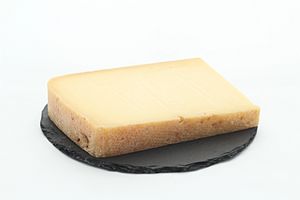Alpkäse facts for kids
Alpkäse is a special type of cheese. It is made from cow's milk in the beautiful Alps mountains. You can find this cheese in countries like Austria, Italy, Switzerland, and Germany.
Alpkäse is known as a "Swiss-type" or "Alpine" cheese. It often has small holes, sometimes called "teardrops." Just like many other hard or semi-hard cheeses, Alpkäse gets more flavor as it ages. The longer it is stored, the richer its taste becomes.
In the Trentino Alto Adige region of Italy, Alpkäse is made from cow's milk. There are over 60 different kinds of cheese from this area. Some examples include Asiago Antico Maso Rosso and Asiago Pressato Trentino.
Austria
In Austria, Alpkäse is a hard cheese. It tastes and feels similar to another cheese called Vorarlberger Bergkäse. The main difference between them is when and where they are made.
- Bergkäse is made all year round. It comes from lower mountain areas, between 600 and 1500 meters high. Even in winter, when cows stay in barns and eat hay, Bergkäse is produced.
- Alpkäse is only made in the summer. This is usually from May to September. It comes from high mountain meadows, above 1500 meters. These high areas are called Alpine pastures or "alps." Here, cows graze on fresh Alpine herbs. This makes Alpkäse a special seasonal product.
Two well-known Austrian Alpkäse cheeses are Vorarlberger Alpkäse and Tiroler Alpkäse. Both of these have a special label called PDO. PDO stands for "Protected Designation of Origin." This means the cheese must be made in a specific place using traditional methods.
Making Alpkäse is closely linked to an old farming tradition. This tradition is called Alpine transhumance. It means moving farm animals, like cows, to different pastures depending on the season. They go to high mountain pastures in summer and lower areas in winter.
See Also


